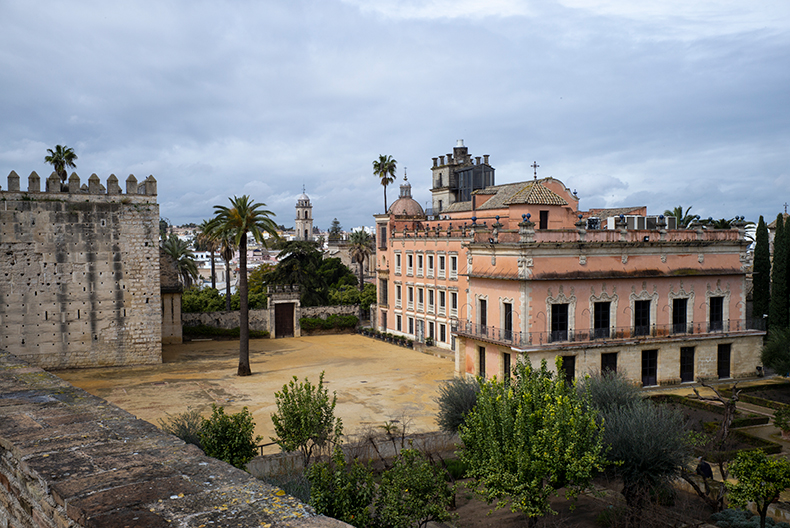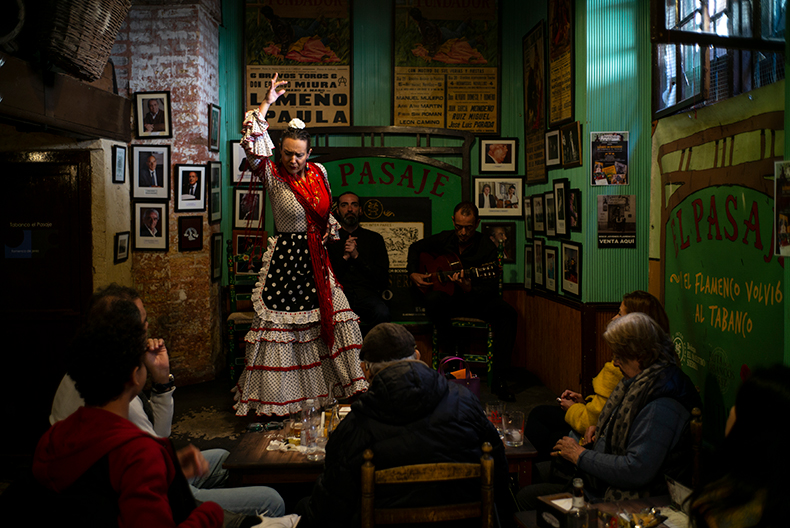Flamenco, sherry, culture and charm in Jerez de la Frontera
Words + Photography Lia Crowe
Every year, for two weeks in February and March, flamenco lovers from around the globe descend on Jerez de la Frontera for the annual Festival de Jerez, a flamenco festival that offers all levels of flamenco classes and nightly shows, ranging from large-scale theatre productions to intimate performances in the beautiful bodegas and midnight showings of the hottest new flamenco talents in the local peñas.
After 20 or so hours of travel I find myself strolling the vibrant evening streets of Jerez de la Frontera, a small Spanish city in Andalusia, in a jet-lagged haze.
People are spilling out of the tiny sherry bars on to the streets, beer or sherry in hand, plates of olives, meats and cheese on small, tall tables in front of them. Along the busiest stretch of the Calle Larga, a wide, pedestrian-only street, my ear catches the unmistakable sound of the thing that has lured me to Spain in the first place—flamenco.
I follow the sounds of people shouting “Olé!” into a little “tablao” (an intimate flamenco venue) called Tabanco El Pasaje, elbow my way up to the bar and quickly utter a few of the Spanish words I know: “Oloroso (sherry), queso (cheese), y aceitunas (olives), por favor.”
I turn toward a small stage in one corner, and above the heads of the crowd I can see a flamenco dancer; her face squinched into a passionate grimace, skirt held high in her hands as her feet tap out a complex rhythm. A guitarist and singer are also on stage and playing in sync with the dancer as she crescendos to a feverish speed, holding us all in a trance with the repetitive rhythm.
Transfixed, I lift the little cylindrical glass of sherry to my lips and realize that tears of happiness are streaming down my cheeks. I’m standing in little tapas bar, which probably hasn’t changed since the 1920s, in the city known as the birthplace of flamenco, saturated in an art form that has the power to capture a person, heart and soul, as it has for me.
Every year, for two weeks in February and March, flamenco lovers from around the globe descend on Jerez de la Frontera for the annual Festival de Jerez, a flamenco festival that offers all levels of flamenco classes and nightly shows, ranging from large-scale theatre productions to intimate performances in the beautiful bodegas (sherry wineries) and midnight showings of the hottest new flamenco talents in the local peñas (flamenco cultural clubs).
Since I am a long-time flamenco aficionado and student of the art form, the festival is part of the reason I have journeyed across the world to visit. The other is to vacation with my boyfriend, Peter, who is a newbie to flamenco. He arrived a couple days after me and also planned to join in on all things flamenco, as well as discovering all the other incredible things Jerez has to offer, which, I soon learn, is a bounty of flavourful, cultural and historical experiences.
The history of Jerez stretches way back to Palaeolithic times. However, the main city really developed during the Almoravid and Almohad dynasties (11th and 12th centuries) when Spain was taken over by the Moors from North Africa prior to being taken by the Christians in the 13th century.
This history was on full display as we visited the city’s monumental Alcázar, a Moorish fortress, which stands proudly as a testament to Jerez’s ancient past. As we wandered through the intricate courtyards and manicured gardens, the sound of trickling water from the many fountains created a soothing soundtrack to our exploration, while the vibrant tiles adorned with geometric patterns added a burst of colour.

Adjacent to the Alcázar lies the breathtaking Cathedral of Jerez de la Frontera. Built in the 17th century, the cathedral’s stunning baroque architecture and ornate interior make it a must-visit landmark. We climbed to the top of the bell tower for panoramic views of the city, admiring a sea of whitewashed buildings and picturesque view.
By day three of the two-week Festival de Jerez, we had settled into a rhythm, trying to emulate Spanish life as much as we could. In the morning we headed directly to Entre Vinos Y Arte, one of many outdoor cafes, for “café con leche y pan tostado con tomate” (coffee with milk and toasted bread with tomato). The proprietor, dressed in a crisp pressed apron, cued up our order, with a simple nod of the head as soon as he saw us walking up the road. From there we headed to our individual dance classes, beginner classes for Peter and more advanced classes for me.
The streets and plazas of Jerez resounded with the music of flamenco, flowing from the dance studios, now packed with flamencophiles from around the world, all eager to learn from Spain’s renowned dancers, and each class featuring live guitar and singing by equally legendary flamenco artists. In addition to learning the complicated steps, a lot of discovery comes from just being in a room with these artists: the way they express, the passion that flows from them and their fearless, authentic energy.
Later in the afternoon, Peter and I would meet at the Mercado Central de Abastos, a huge market full of vendors selling gorgeous produce: endless varieties of olives, meats, fish, cheese and Spanish specialties such as membrillo (quince paste), which we discover pairs nicely with queso fresco (fresh cheese).
Then came the walk home though the narrow, sun-warmed streets that weave through pastel-coloured buildings reminiscent of a movie set, for some fresh market food and the necessary siesta to rest up for the night’s activities.
The night started with a few tapas and a glass of sherry, and then to the theatre. As part of the festival a large-scale flamenco production unfolds every night at the Teatro Villamarta, highlighting the most prominent flamenco artists. Here, the audience gets involved with waves of jaleos (calls of encouragement) such as “Olé!” “Guapa!” and “Toma!”
After the theatre performance, now about 10 pm, came dinner at Meson del Asador, where we devoured plates of cod with tomato, fried peppers, Iberian pork and fried potatoes—all washed down nicely with Spanish reds, beer or a dry sherry. Then—more flamenco, each night more spectacular than the last.
Within that daily routine, we sometimes relaxed in one of the many palm-treed plazas, sipping something cold, wandered through streets heavily perfumed with orange blossoms or checked out the city’s attractions, like the Royal Andalusian School of Equestrian Art. The school’s grounds boast majestic gardens filled with mature exotic plants and, in addition to pristine riding rings, museums, stables and show arena, include the Palacio del Recreo de las Cadenas, a beautiful example of 19th-century French architecture, designed by the same architect as the Palais Garnier in Paris.
But truly, the real diamonds on this crown were the horses and riders. We attended a horse show, which featured an equestrian ballet of classic dressage set to Spanish music with the skilled riders (graduates of the school) dressed in elaborate 18th-century costumes.
As our two weeks were coming to an end, we realized that missing from our Jerez experience was a deeper dive into sherry. Jerez’s legacy is so intricately tied to its world-famous fortified wine, the word Jerez translates to sherry and the city is home to numerous bodegas that produce this exquisite drink.
We toured Bodegas Fundador, the maker of the world-famous Harveys Bristol Cream, where our knowledgeable guide, Fatima, led us through the winemaking process and intricate aging techniques. Their cellar, named “la mezquita” (the mosque), is an incredible monument: a vast building with columns that stretch in all directions, giving the cellar a sense of infinity. The highlight, of course, was the tasting session, where we delighted in the diverse flavours and aromas of the different sherries. Each sip was a revelation, a testament to the craftsmanship and tradition that define Jerez’s sherry production.
As we left Jerez, we reflected how this charming city had left a mark on our hearts and souls. From its rich history and cultural heritage to its warm and welcoming people, Jerez offered us an unforgettable journey of discovery. We left with the echoes of flamenco rhythms, the taste of exquisite sherry and the memories of a city that had truly captivated us. Jerez, with its timeless allure, will forever remain etched in our minds as a place of magic, passion and inspiration.


 Secrets and lives — and the 7 sins with Martin Mayer
Secrets and lives — and the 7 sins with Martin Mayer